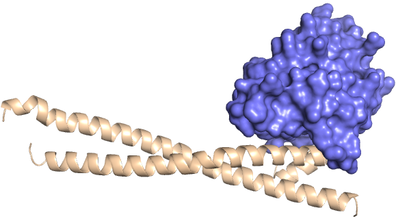
Influenza A virus (IAV) is responsible for the majority of seasonal flu cases resulting in more than 30,000 deaths every year in the United States alone. Moreover, occasional emergence of pandemic IAV incapacitates vaccines and infects millions of people worldwide. Four major flu pandemics occurred in the past 100 years, most recently in 2009. The deadliest one, which is popularly termed “Spanish flu”, occurred in 1918 and resulted in more than 50 million deaths worldwide. Although the genome of 1918 IAV was determined, the molecular determinants of the high virulence of the 1918 IAV remain unknown.
We are interested in studying the molecular recognition mechanisms between 1918 IAV proteins and human signaling proteins, such as CRK and PI3K. The picture above shows our crystal structure of the complex between a 1918 IAV protein and the human p85-beta subunit of PI3K. In addition, we seek to develop inhibitors blocking the interactions between IAV and host proteins.
We are interested in studying the molecular recognition mechanisms between 1918 IAV proteins and human signaling proteins, such as CRK and PI3K. The picture above shows our crystal structure of the complex between a 1918 IAV protein and the human p85-beta subunit of PI3K. In addition, we seek to develop inhibitors blocking the interactions between IAV and host proteins.
Do you want to know more about the Spanish flu? Click the link below.
https://www.vaccinestoday.eu/stories/100-years-spanish-flu-world-ready-next-pandemic/
https://www.vaccinestoday.eu/stories/100-years-spanish-flu-world-ready-next-pandemic/
